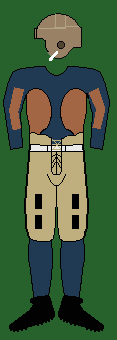1927 Michigan Wolverines football team
The 1927 Wolverines also lost back Bo Molenda who went on to play nine seasons in the National Football League.
Between May 9 and September 1, 1927, more than 11,000 yards of concrete were poured along with installation of 440 tons of reinforcing steel and 31,000 square feet of wire mesh.
With athletic director Yost supervising every step in the process, the stadium was reportedly completed "on time and within budget," with the cost of construction totaling $1,131,733.36.
[2] On September 15, 1927, with construction of the new stadium in its final phase, Yost at age 56 announced his resignation as Michigan's head football coach.
Yost cited his ongoing responsibilities as the school's athletic director, including construction of the new football stadium and a new intramural building, as the reason for his resignation.
The opponent scheduled was Ohio Wesleyan University, where Fielding H. Yost had begun his coaching career in 1897.
[7][8] An account written for the Bentley Historical Library at the University of Michigan indicates that the discrepancy was likely due to the fact that thousands of high school students attended the game for free.
He also threw touchdown passes to quarterback Leo Hoffman and left end Bennie Oosterbaan.
Michigan's first two touchdowns came on running plays by halfback Louis Gilbert and fullback George Rich, and the third came on a pass from quarterback Leo Hoffman to left end Bennie Oosterbaan.
Michigan's touchdowns were scored by fullback George Rich and left halfback Louis Gilbert.
Rich's touchdown came in the second quarter after quarterback Leo Hoffman advanced the ball 26 yards to the one-foot line on a "triple pass".
[12] The second touchdown followed a Wisconsin fumble at its own one-yard line with Michigan's left tackle Otto Pommerening recovering the loose ball.
Before the game began, the Governors of Michigan (Fred W. Green) and Ohio (A. Victor Donahey) and other dignitaries followed the two university bands onto the field for the playing of "The Star-Spangled Banner".
Ann Arbor flung open its gates to a horde of visitors nearly triple the size of its own population-and the new stadium swallowed them by two o'clock in the afternoon.
Michigan played without its backfield star, Louis Gilbert, who was injured the prior week when he threw three touchdown passes against Ohio State.
The first Illinois touchdown followed a fumble by Gilbert's replacement, William Puckelwartz, at Michigan's seven-yard line.
Michigan's first points came in the third quarter on a trick play in which Bennie Oosterbaan took the ball from quarterback James Miller on what appeared to be an end run from the two-yard line.
[24][25] Walter Eckersall served as the game's referee and wrote in the Chicago Tribune: "For hard, aggressive playing combined with splendid sportsmanship it was one of the best struggles I ever officiated in.





